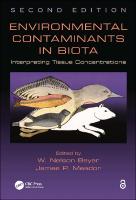Environmental Contaminants in Biota
Proposal review
| dc.contributor.editor | Bey, W. Nelson | |
| dc.contributor.editor | Meador, James P. | |
| dc.date.accessioned | 2020-07-23T15:34:31Z | |
| dc.date.available | 2020-07-23T15:34:31Z | |
| dc.date.issued | 2011 | |
| dc.identifier | ONIX_20200723_9781420084054_11 | |
| dc.identifier | OCN: 1247597221 | |
| dc.identifier.uri | https://library.oapen.org/handle/20.500.12657/40059 | |
| dc.description.abstract | amining tissue residues of contaminants in biota reveals the movement of contaminants within organisms and through food chains as well as the context for understanding and quantifying injuries to organisms and their communities. Yet tissue concentrations of some contaminants are especially challenging to interpret and the ability of today’s analytical chemists to provide reliable analytical data of most important environmental contaminants often surpasses the ability of ecotoxicologists to interpret those data. Offering guidance on the ecotoxicologically meaningful interpretation of tissue concentrations, Environmental Contaminants in Biota, Interpreting Tissue Concentrations, Second Edition is updated with current data and new ways of analyzing those data as well as additional contaminants not previously considered. Beginning with a history of wildlife toxicology and data interpretation, chapters cover a wide range of contaminants and their hazardous and lethal concentrations in various animals including DDT, Dioxins, PCBs, and PBDEs in aquatic organisms; methylmurcury, selenium, and trace metals in fishes and aquatic invertebrates; and pharmaceuticals and organic contaminants in marine mammals. The book considers the impact of Polychlorinated Biphenyls, Dibenzo-p-Dioxins and Dibenzofurans, and Polybrominated Diphenyl Ethers; cyclodiene; and other organochlorine pesticides in birds and mammals. Later chapters examine the effects and analysis of lead, cadmium, and radionuclides in biota. With thousands of published research papers reporting tissue concentrations each year, Environmental Contaminants in Biota, Interpreting Tissue Concentrations, Second Edition gives ecotoxicologists the ability to draw actionable value regarding the toxicological consequences of those concentrations and relate tissue concentrations quantitatively to injury: the core of ecotoxicology. | |
| dc.language | English | |
| dc.subject.classification | thema EDItEUR::R Earth Sciences, Geography, Environment, Planning::RN The environment::RNC Applied ecology | en_US |
| dc.subject.classification | thema EDItEUR::T Technology, Engineering, Agriculture, Industrial processes::TQ Environmental science, engineering and technology | en_US |
| dc.subject.classification | thema EDItEUR::P Mathematics and Science::PS Biology, life sciences | en_US |
| dc.subject.classification | thema EDItEUR::P Mathematics and Science::PS Biology, life sciences::PSV Zoology and animal sciences | en_US |
| dc.subject.other | 2e | |
| dc.subject.other | Biota | |
| dc.subject.other | Concentrations | |
| dc.subject.other | Contaminants | |
| dc.subject.other | Environmental | |
| dc.title | Environmental Contaminants in Biota | |
| dc.type | book | |
| oapen.identifier.doi | 10.1201/b10598 | |
| oapen.relation.isPublishedBy | 7b3c7b10-5b1e-40b3-860e-c6dd5197f0bb | |
| oapen.imprint | CRC Press | |
| oapen.pages | 769 | |
| peerreview.anonymity | Single-anonymised | |
| peerreview.id | bc80075c-96cc-4740-a9f3-a234bc2598f1 | |
| peerreview.open.review | No | |
| peerreview.publish.responsibility | Publisher | |
| peerreview.review.stage | Pre-publication | |
| peerreview.review.type | Proposal | |
| peerreview.reviewer.type | Internal editor | |
| peerreview.reviewer.type | External peer reviewer | |
| peerreview.title | Proposal review | |
| oapen.review.comments | Taylor & Francis open access titles are reviewed as a minimum at proposal stage by at least two external peer reviewers and an internal editor (additional reviews may be sought and additional content reviewed as required). |

